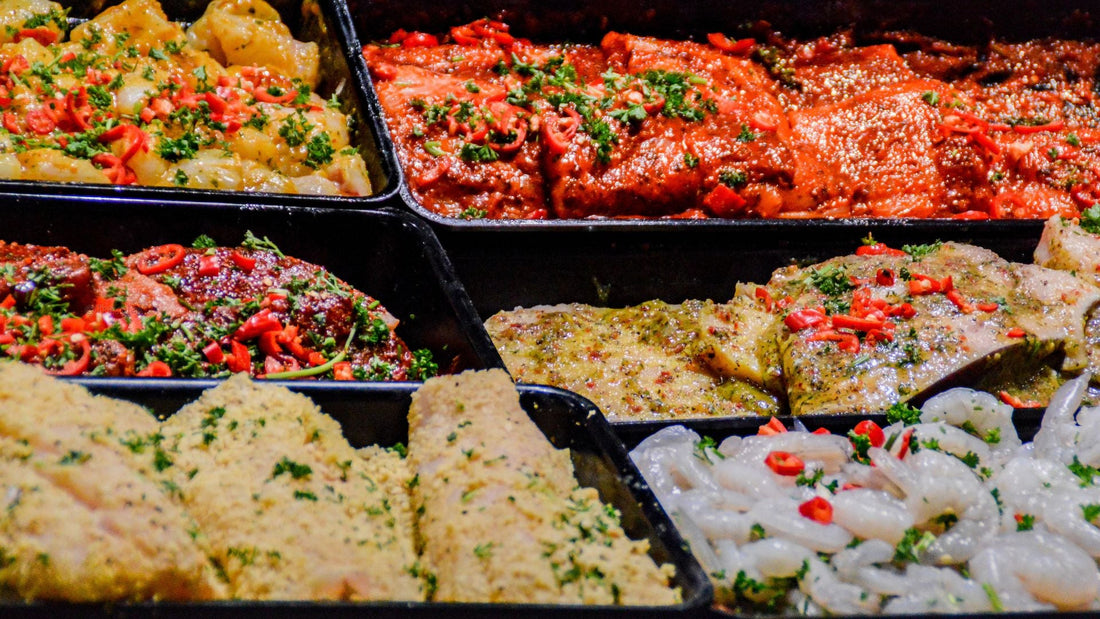
17 Game-Changing Food Hacks That Will Transform Your Travel Experience in 2025
Share
Food is no longer just fuel for travelers—it's the destination itself. With culinary tourism surpassing $1 trillion in value and half of all travelers now booking restaurant reservations before their flights, dining has become a top priority for modern explorers. But here's the secret that savvy travelers know: experiencing incredible local cuisine doesn't require draining your travel fund. Armed with the right strategies, you can savor authentic flavors, discover hidden culinary gems, and still have money left for that sunset cocktail.
The Grocery Store Revolution
Your first stop after landing shouldn't be a restaurant—it should be the local grocery store. This simple habit can cut your food budget by 40-60% while offering an authentic glimpse into local life that no tourist restaurant can match. Stock up on breakfast essentials, picnic ingredients, and snacks that prevent desperate (and expensive) convenience store runs.
European grocery chains like Lidl and Aldi offer incredible prepared foods for €3-5, while Asian markets feature hot meal sections with authentic dishes for under $4. Latin American supermercados sell freshly made empanadas, tamales, and street food classics at local prices. The key is thinking like a resident, not a tourist—grab what locals grab, and you'll eat well for less.
Book accommodations with kitchen access whenever possible, even if the nightly rate is slightly higher. Preparing just one meal daily can save a family of four $200-300 per week, and breakfast on a scenic balcony beats any hotel buffet. Pack a collapsible kettle and your favorite coffee to avoid $10 daily café runs—this alone saves over $300 on a month-long trip.
Master the App Economy
Technology has revolutionized budget dining with apps that connect travelers to serious savings. Too Good To Go partners with bakeries, restaurants, and cafés to sell end-of-day surplus at 50-70% discounts—think $6 for 23 fresh bagels or $5 for four pizza slices plus garlic knots. The app is free, lets you set your search radius, and turns food waste into wallet wins.
LocalEats filters out tourist traps and chains, directing you exclusively to authentic neighborhood spots where locals actually dine. Search by cuisine, price range, and neighborhood, or enable GPS to discover hidden gems within walking distance. For immersive experiences, Eatwith and Withlocals connect travelers with home cooks and food tour guides for authentic meals and market visits at reasonable prices.
Restaurant loyalty apps deserve space on your phone too—Chili's offers free chips and salsa or beverages with regular visits, while dozens of chains provide birthday freebies and rewards points that add up quickly. Download apps for restaurants you know you'll visit, then check their special offers section before ordering.
Strategic Timing Is Everything
When you eat matters as much as where you eat. Lunch menus feature identical dishes to dinner selections but cost 30-50% less—a $28 dinner entrée typically costs $12-16 at lunch. Many restaurants serve lunch until 4 PM, meaning you can enjoy an "early dinner" at lunch prices and save substantially over time.
Happy hour extends beyond drinks to include discounted appetizers that, when combined strategically, create a full meal for half the price. Some establishments offer reverse happy hour specials late in the evening, perfect for night owls and late diners. Early bird specials at traditional restaurants typically run from 4-6 PM and offer 15-25% off regular menu prices.
Daily specials posted on rotating schedules represent better value than one-day surprise specials, which restaurants sometimes use to move aging inventory. Research restaurant websites before visiting to identify which days feature your preferred proteins or preparations at discounted rates.
The Market and Food Hall Renaissance
Food halls and public markets have exploded in popularity, offering diverse, affordable options under one roof. Singapore's hawker centers serve Michelin-quality dishes for under $3, while European market halls feature everything from paella to oysters at fraction-of-restaurant prices. American cities from Austin to Brooklyn have embraced this model, with food halls providing sampling opportunities and smaller portions that let you try multiple cuisines affordably.
Farmers markets become budget goldmines in their final hour—vendors prefer selling at discount rather than packing up inventory. Arrive 30-60 minutes before closing to negotiate bulk deals on fresh produce, artisan breads, and prepared foods. Many markets now accept credit cards and offer international cuisine from local immigrant communities at authentic prices.
Food trucks and street vendors often deliver restaurant-quality food at 60-70% lower prices because they lack brick-and-mortar overhead. Latin American cities excel at street food culture, with complete meals available for $2-5. Vietnamese districts serve bánh mì and phở for under $4, while Middle Eastern neighborhoods offer shawarma and falafel platters that easily feed two for $10-12.
The Picnic Strategy
Assembling grocery store picnics transforms sightseeing into dining experiences. A reusable insulated bag packed with cheese, charcuterie, fresh bread, fruit, and local specialties costs $15-20 but rivals $60-80 restaurant meals in quality and certainly exceeds them in ambiance. European grocery stores offer pre-packaged picnic items including wine, while Asian markets provide sushi-grade ingredients and prepared sides.
Strategic packing makes picnicking seamless—bring lightweight reusable bags (many countries charge for plastic bags), a small cutting board, and a multi-tool with corkscrew. Pack a compact blanket or large scarf that doubles as ground cover. Identify scenic picnic spots in advance: park overlooks, waterfront benches, historic squares, and botanical gardens all provide free "dining rooms" with million-dollar views.
This approach shines particularly in expensive destinations like Hawaii, Iceland, Switzerland, and Scandinavia where restaurant meals devastate budgets but groceries remain relatively reasonable. On a week-long Hawaiian vacation, one family spent under $400 total on food by making breakfasts, having grocery picnics for lunch, and dining out selectively for dinner.
Drink Smarter, Not Harder
Beverage costs often rival food expenses, but strategic choices create substantial savings. Order water with lemon instead of sodas or juices—it's always free and keeps you hydrated in warm climates. Skip wine and beer at restaurants where markups reach 200-400%, and instead enjoy drinks during pre-dinner happy hours at your accommodation using grocery store purchases.
Some restaurants allow BYOB (bring your own bottle) wine for corkage fees ranging from $10-40—still cheaper than restaurant wine pricing. Call ahead to confirm policies, and bring a quality bottle from a local wine shop to enhance the experience. This works particularly well for special occasion dinners where wine selection matters.
The tempo drinking movement has gained momentum in 2025, with 25% of global travelers reducing or eliminating alcohol consumption. This shift toward mindful drinking saves money while improving travel experiences—clearer heads mean better memories, decision-making, and morning energy. Many innovative restaurants now feature "spirited and free-spirited" menus with creative mocktails that cost half the price of alcoholic equivalents.
Budget-Friendly Culinary Destinations for 2025
Certain destinations deliver extraordinary food experiences at remarkably low costs. Oaxaca, Mexico represents Mexico's culinary heart, with complex moles, fresh tlayudas, and mezcal tastings available for $3-8 per meal. Street vendors and small fondas serve authentic dishes that restaurants in tourist areas charge triple for.
Vietnam dominates the street food category, with Hanoi and Ho Chi Minh City offering bánh xèo, phở, and grilled pork dishes for under $2. District 1 in Ho Chi Minh City features the world's best street food density, with international influences and late-night options. Michelin-approved spots serve dim sum and Peking duck at shockingly affordable prices.
Kraków, Poland surprises visitors with creative, budget-friendly dining where hearty pierogi, żurek soup, and potato pancakes fill you up for $5-8. Even Michelin-approved restaurants like Karakter offer unbeatable set lunch menus featuring inventive dishes with local ingredients. Penang, Malaysia might be the cheapest food destination globally, with char kway teow, laksa, and roti canai available for under $2 at dozens of Michelin-recommended hawker stalls.
Restaurant Hacks from the Pros
Travel expert Rick Steves advocates for takeout over dine-in, noting that European bakeries, delis, and prepared food shops offer identical quality at 40-60% lower prices without table service charges. Asian groceries typically feature hot food bars with pay-by-weight options perfect for customizing budget-friendly meals.
Sharing entrées makes financial sense at restaurants serving American-sized portions—most establishments provide extra plates for minimal fees, and splitting a $24 entrée beats ordering two $18 dishes. Alternatively, immediately box half your meal for tomorrow's lunch before eating, preventing both waste and additional meal costs.
Skip appetizers unless making them your meal strategy—restaurant portions typically provide more than enough food without starters. If dining at small-plate restaurants currently trending in 2025, ask about portion sizes before ordering to avoid over-ordering. Bread baskets and pre-meal chips may seem free but often add $3-6 to your bill—request they be removed if you don't want them.
Loyalty Programs and Gift Card Strategies
Restaurant gift cards purchased through Costco, Sam's Club, or discount websites sell at 15-25% below face value. Buy $100 in gift cards for $80-85, then use them at full value—instant savings on every meal. Black Friday brings restaurant promotions like "Buy $40, Get $10 Free," effectively providing 20% returns on future dining.
Credit card dining programs offer substantial value when used strategically. American Express frequently runs restaurant offers providing $10-25 credits when spending thresholds are met at specific chains. Discover, Chase, and Capital One feature rotating dining categories with 5% cashback, while dedicated dining cards like the Capital One SavorOne earn 3% back at all restaurants.
Email lists for favorite restaurants deliver exclusive coupons, birthday rewards, and preview access to limited-time promotions. Creating a dedicated email address for restaurant subscriptions keeps your primary inbox clean while ensuring you don't miss valuable offers.
Embrace Vegetarian and Regional Options
Plant-based menu items typically cost 20-40% less than meat-centered dishes while providing equally satisfying meals. The 2025 trend toward health-conscious, vegetarian-friendly options means restaurants now offer creative plant-based choices beyond sad salads. Indian, Middle Eastern, and Asian cuisines excel at vegetarian cooking, with dishes like dal, falafel, and tofu stir-fries delivering protein and flavor at budget prices.
Regional and ethnic neighborhoods offer authentic cuisine at local prices rather than tourist markups. Chicago's Devon Avenue serves outstanding Indian food at neighborhood rates, while Argyle Street features phenomenal Vietnamese options. Every major city has ethnic enclaves—research them before visiting to experience authentic flavors without inflated pricing.
Bold, regional flavors dominate 2025 food trends, with consumers seeking specific regional specialties rather than generic national cuisines. This shift benefits budget travelers because authentic regional restaurants in immigrant neighborhoods charge less than trendy fusion spots while delivering superior authenticity.
Plan Ahead for Maximum Savings
Advanced planning separates smart spenders from budget busters. Research destinations for fixed-price menus, happy hour timing, and special dining events before arriving. Many countries feature prix fixe lunch menus offering three courses for less than single entrée prices. German Christmas markets and Oktoberfest celebrations provide abundant, affordable food in festive settings.
Create a flexible meal plan balancing splurge dinners with budget breakfasts and lunches. If you're spending $80 on a special dinner, offset it with $5 breakfast and $12 lunch—your daily average remains reasonable while still enjoying highlight experiences. Track spending through simple notes apps to maintain awareness without obsessing.
Use mapping apps to identify affordable, highly-rated options near your accommodation and planned activities. Google Maps, Yelp, and TripAdvisor allow filtering by price range, cuisine, and user ratings—spend 20 minutes researching before trips to build a saved list of vetted options. This prevents desperate "let's just eat here" decisions that derail budgets.
